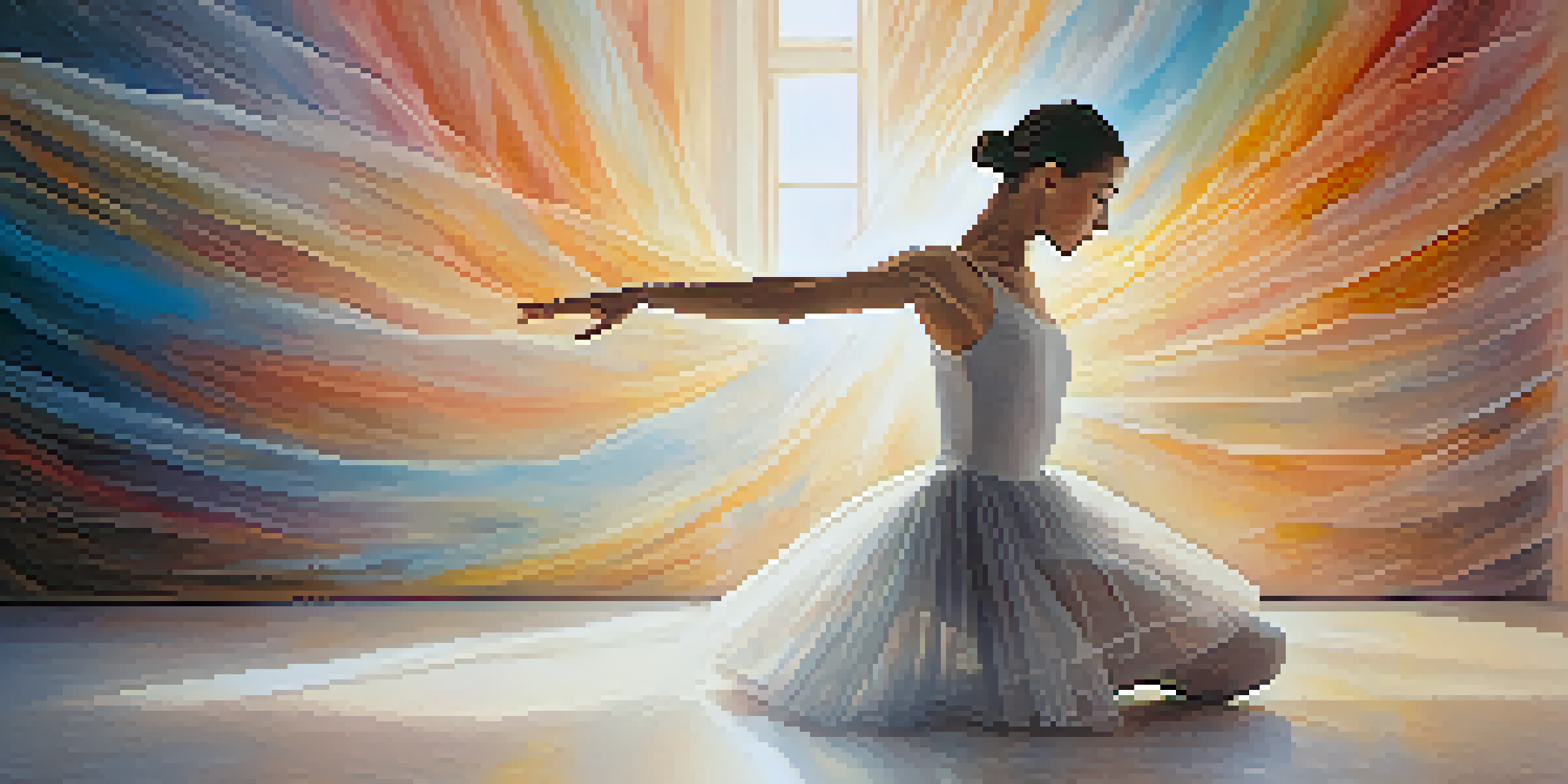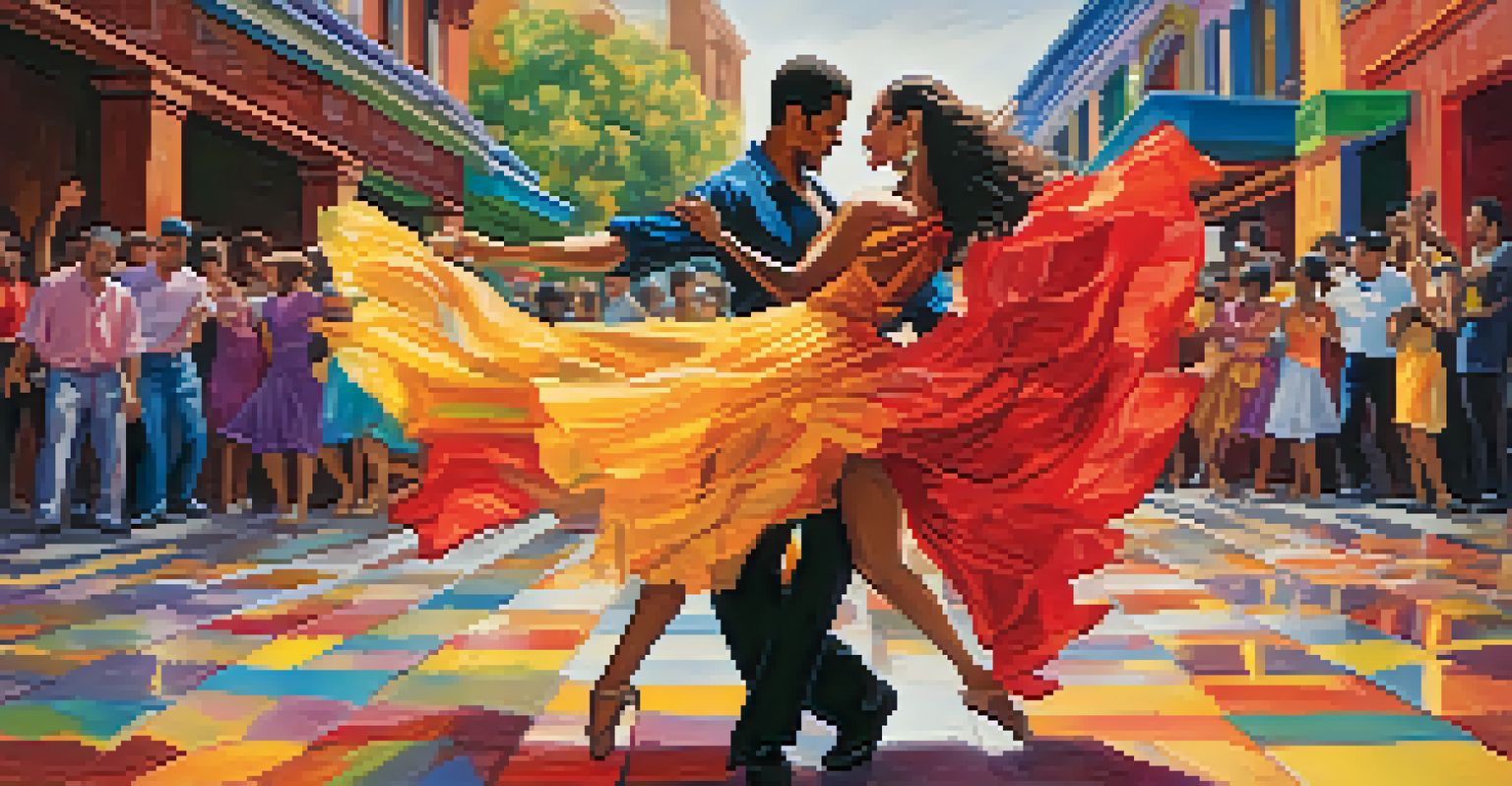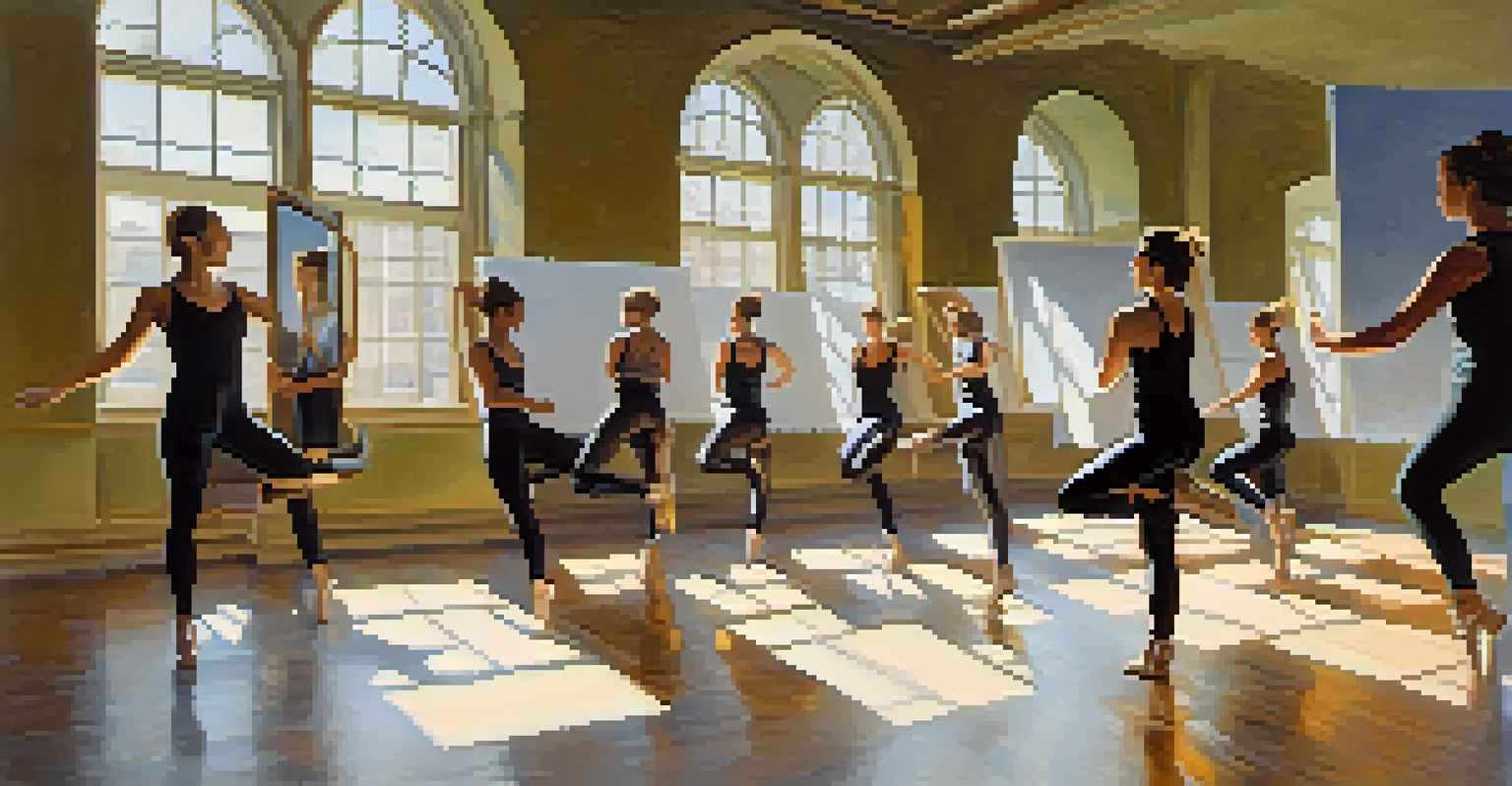The Relationship Between Dance and Visual Art Forms

The Essence of Movement in Dance and Artistic Expression
At its core, dance is a form of movement that communicates emotions and stories. Just like visual art, it captures the essence of human experience, allowing both the dancer and the viewer to engage in a shared journey. The fluidity of a dancer's body can evoke feelings similar to those stirred by a beautifully painted canvas.
Dance is the hidden language of the soul.
Think of a ballet performance; each movement is akin to a brushstroke on a canvas, painting a narrative through motion. The grace of a pirouette or the sharpness of a leap can convey joy, sorrow, or tension—emotions that are also expressed in visual art forms. Thus, both mediums rely on the power of expression to resonate with their audiences.
When we analyze dance through the lens of visual art, we see how the two can enhance each other. A stunning piece of choreography can be likened to an abstract painting, where every gesture adds depth and complexity, inviting viewers to interpret the performance much like they would a sculpture or a mural.
Historical Perspectives: Dance and Art Through the Ages
Throughout history, dance and visual arts have been intertwined, influencing each other in remarkable ways. Ancient civilizations often depicted dancers in their art, showcasing how integral movement was to their culture. From the cave paintings of dancers in prehistoric times to the elegant figures in classical sculptures, this bond is evident.

In the Renaissance, artists like Leonardo da Vinci and Michelangelo explored human anatomy and movement, which in turn inspired choreographers to create more realistic and expressive dance forms. The fluidity of their figures paved the way for ballet, where precision and beauty became paramount. This period marked a significant evolution in both visual art and dance, reflecting culture and society's values.
Dance and Art Share Emotional Depth
Both dance and visual art communicate emotions and stories, allowing audiences to engage in a shared experience.
As we moved into the 20th century, movements like Dadaism and Surrealism began to influence both art and dance, encouraging experimentation and breaking traditional boundaries. Artists and dancers alike sought to challenge norms, leading to innovative collaborations that blurred the lines between the two forms.
The Role of Color and Rhythm in Dance and Visual Arts
Color and rhythm play pivotal roles in both dance and visual arts, creating a sensory experience that captivates audiences. In visual art, colors can evoke emotions and set the mood, much like rhythm in dance dictates the tempo and energy of a performance. The vibrant hues of a painting can mirror the lively movements of a dancer, creating a harmonious dialogue between the two.
Art is the most beautiful of all lies.
Consider how a lively salsa dance might be accompanied by bright, bold colors in a painting. The dynamic movements of the dancers can be reflected in brushstrokes that mimic their energy, creating a visual experience that complements the performance. This synergy between color and rhythm illustrates how interconnected these two art forms truly are.
Moreover, choreographers often use the principles of color theory to influence their work, designing costumes and staging that enhance the overall aesthetic. Just as an artist carefully selects their palette, a dancer's performance can be elevated by the thoughtful integration of color and movement, creating a unified artistic expression.
Choreography as a Form of Visual Art
Choreography itself can be seen as a form of visual art, transforming movement into a tangible creation. Just as an artist composes a piece on canvas, a choreographer arranges movements to tell a story or convey an idea. This intentional structure allows dance to be perceived as a visual narrative, where each movement serves a purpose.
In many ways, choreographers are like painters; they utilize space, timing, and physical expression to craft a masterpiece. The lines created by dancers’ bodies in motion can be likened to the lines in a drawing, creating an engaging visual experience that captivates the audience. This unique perspective encourages viewers to appreciate the artistry behind choreography.
Collaboration Enhances Artistic Expression
The partnership between dancers and visual artists fosters innovative works that redefine and enrich both art forms.
Furthermore, the documentation of dance through video or photography allows choreography to be preserved like a painting. This evolving medium helps bridge the gap between dance and visual arts, showcasing performances in a way that invites further exploration and appreciation.
Collaboration Between Dancers and Visual Artists
Collaboration between dancers and visual artists can lead to groundbreaking works that redefine both forms. When these creatives join forces, they can explore new dimensions of expression, using their respective mediums to enhance one another. This synergy often results in performances that blur the lines between dance and visual art, creating immersive experiences for audiences.
For instance, installations that incorporate live dance can transform a gallery space into a dynamic environment. Dancers moving through a space filled with visual art invite the audience to perceive the artwork from a fresh perspective, as both forms come to life. This collaborative approach not only enriches the viewer's experience but also fosters innovation in both fields.
Moreover, festivals and exhibitions that focus on this intersection emphasize the importance of collaboration. These events encourage artists to push their boundaries, leading to unique projects that celebrate the relationship between dance and visual arts, ultimately inspiring future generations of creatives.
The Impact of Technology on Dance and Visual Arts
In today's digital age, technology has revolutionized the way we experience both dance and visual arts. From digital projections in performances to virtual reality installations, technology allows for new forms of expression that can enhance the relationship between these art forms. This fusion creates immersive experiences that captivate audiences in ways previously unimaginable.
For example, choreographers now experiment with video mapping, projecting visual art onto dance performances to create a multi-sensory experience. This blend of movement and imagery invites viewers to engage with the art in a more profound way, as they are drawn into a world where dance and visual elements coexist harmoniously.
Technology Transforms Artistic Interaction
Digital advancements are creating immersive experiences that blend dance and visual arts, captivating audiences in new ways.
Additionally, social media platforms have provided artists with new avenues to showcase their work, breaking geographical barriers. Dancers and visual artists can collaborate remotely, sharing their creative processes and broadening their audiences. This global reach fosters a vibrant community of artists who continue to explore the relationship between these two dynamic forms.
The Future of Dance and Visual Arts: A New Horizon
As we look ahead, the relationship between dance and visual arts is likely to continue evolving. With the rise of interdisciplinary practices, artists are increasingly blurring the lines between different mediums. This trend encourages experimentation, leading to innovative works that challenge traditional definitions of both dance and visual arts.
Moreover, as societal issues and themes gain prominence, artists are using their platforms to address these topics through collaboration. Dance and visual arts can serve as powerful vehicles for social commentary, drawing attention to important issues while engaging and inspiring audiences. This intersection will likely be a focal point for future artistic explorations.

In conclusion, the dynamic relationship between dance and visual arts is a testament to the power of creativity. As artists continue to push boundaries and explore new possibilities, we can expect to see even more exciting and transformative works that celebrate the rich connection between these two vibrant forms of expression.